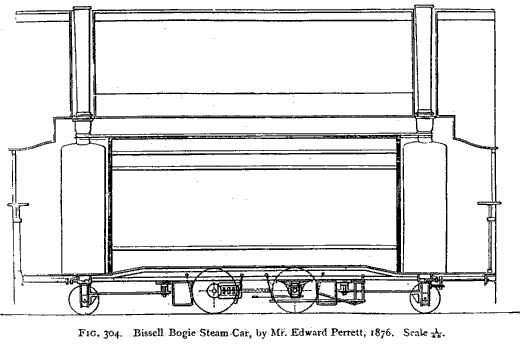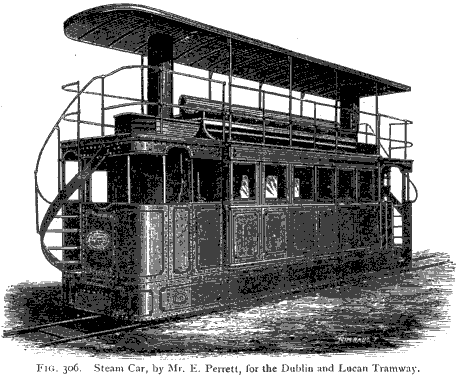This website has been archived from TrainWeb.org/i3 to TrainWeb.US/i3.
![[home]](/i3/graphics/i3.gif) |
Perrettby D. Kinnear Clark |
contents |
The following is transcribed from a reprint of Tramways - Their Construction and Working, by D. Kinnear Clark, with the kind permission of the publisher.
 Perrett
Perrett
Mr. Edward Perrett arranged a steam car, Figs. 304, 305, in which the machinery is placed horizontally under the frame, and two vertical steam-boilers are placed on the platform, one at each end of the car, and connected together. The weight is thus equally distributed, and the car may be run either end formost. The car runs on eight wheels, and weighs 8 tons when loaded, of which 5 tons rest on the four middle wheels, which are driven by the engine, and 3 tons is divided between the for pair and aft pair of wheels. These wheels, fore and aft, are arranged as Bissell trucks, radiating outwards on pivots, and they are controlled at either end by steering gear, so that the car may be taken with facility off the road, on to a branch, or vice versa. The fixed wheel-base -- that of the driving wheels -- is 4 feet, and the total wheel-base is 17 feet. The two cylinders are 6 inches in diameter, with a stroke of 9 inches; the coupled driving wheels are 27 inches in diameter, and the bogie wheels are 18 inches. The steam boilers, on Broadbent's system, are 13½ inches in diameter outside, and 6 feet long; the fire-box is 20½ inches diameter at the grate, giving 2.27 square feet of grate-area for each boiler.

An experimental steam car was constructed on this system, with 5-inch cylinders, and an 8-inch stoke; 27-inch driving wheels at 4-feet centres, and 19-inch bogie wheels, at 14-feet centres; 1.60 square feet of grate for each boiler; total weight, 8 tons, of which 5 tons was driving weight. It was publicly tried in May, 1876; and it is reported that the car ran easily on a circular line of 35 feet radius, to a gauge of 4 feet 8½ inches, with a pressure of 90 lbs. per square inch in the boiler, curring off at 5-8ths of the stroke; though it was necessary to get up the pressure to 120 lbs. per square inch before starting again. With a pressure of 120lbs. the car could start on an incline of 1 in 30.
A car of this type, Fig. 306, was constructed by Messrs. Manlove, Alliott, Fryer & Co., Nottingham, for the Dublin and Lucan Tramway. The cylinders are 7 inches in diameter, with a stroke of 9 inches, and four coupled 27-inch wheels, 4½ feet apart between centres. The total wheel-base, including the Bissell trucks, one at each end, is 17½ feet. The car in working order, without passengers, weighs 9 tons. A series of tests of this car were made on an endless tramway, 3 feet in gauge, a quarter of a mile in length, on the premises of Messrs. Manlove & Co., to prove the amount of the gross resistance. Indicator-diagrams were taken from the engines, yielding the following results:-
On a straight line, with ascending gradients of 1 in 57 and 1 in 22, the indicator frictional resistances, after allowing for the resistance of gravity, were, at 4 miles per hour, at the rate of 35 lbs. and 36 lbs. per ton on the two gradients respectively; and at 8 miles per hour, 41 lbs. and 39 lbs. On a curve, of 60 feet radius, on a level, the resistances were 81 lbs. and 96 lbs.; going up an incline 1 in 41, they were 50 lbs. and 75 lbs.; up 1 in 33, they were 65 lbs. and 84 lbs. per ton. The mean results may be taken thus :--
| Steam Car | 4 miles per hour. | 8 miles per hour. |
|---|---|---|
| Straight line, frictional resistance | 36 lbs. per ton | 40 lbs. per ton |
| Curve, 60 feet radius, frictional resistance | 65 lbs. per ton | 85 lbs. per ton |
Here it appears that the resistance on a curve of 60 feet radius is, in round numbers, double the resistance on a straight line. This result compares unfavourably with the result of trials for the tractional resistance of a passenger-car on the same line of way, page 405, where it was deduced that the straight-line resistance of a car was little more than doubled even on a curve of 22 feet radius. It is probable that the greater resistance of this steam-car is attributable not alone to the working of the propelling machinery as such; but also to the spread and the arrangement of the wheel system. The fuel -- gas coke -- for a run of 6 miles, at a speed of 8 miles per hour, was consumed at the rate of 17 lbs. per mile, or nearly 2 lbs. per ton-gross per mile. Of course, the great and unequal resistance of inclines and curves contributed to the causing of so considerable a consumption of fuel.
This steam car was set to work on the Dublin and Lucan Tramway, on June 6, 1881, working between Dublin and Chapelizod, a length of two miles, making 13 double trips, equal to 52 miles per day. The car, weighing 9 tons empty, weighs with 1½ tons of passengers, the average load of 10½ tons-gross. The fuel consumed per day is 6 cwt. of gas coke, including the fuel consumed for getting up steam, equivalent to 1.3 lb per ton-gross per mile. This comparatively high rate of consumption may be accounted for, to some extent at least, by the unfavourable conditions under which the work was done. The car makes but one double-trip or 4-mile run in each hour. In fact, the 2-mile trip was made in 10 minutes, and the car was at rest for forty minutes in each hour.
| i3@rrmail.com | 2002.07.21 |
















